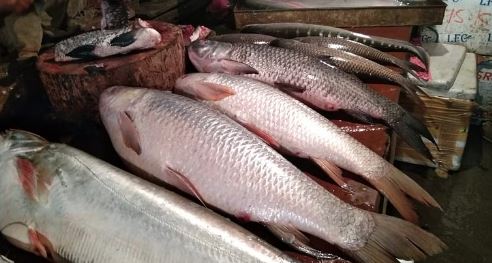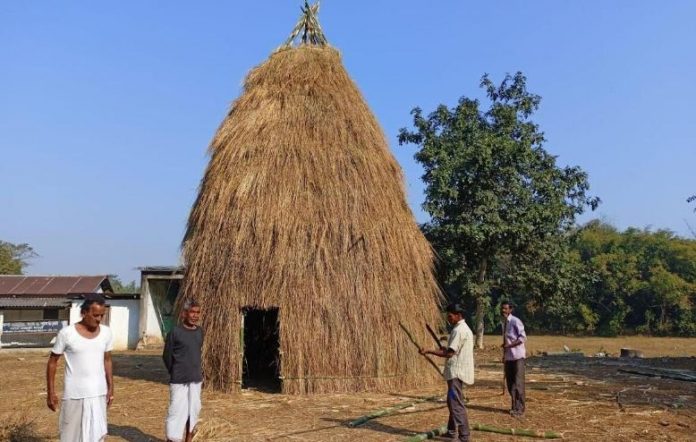In view of the forthcoming Bhogali Bihu festival, preparations are being done on a large scale to celebrate the auspicious harvest festival in Dibrugarh.
Magh Bihu falls in the local month of ‘Magh’ during mid-January. It is also called ‘Bhogali Bihu’ as it is celebrated with community feasts after the annual harvest takes place.
People across Assam flocked to the markets, particularly to the fish markets, beating the morning chill to buy the best quality fish.

The Bhogali festival, which marks the end of the harvesting season in the month of Magh, will be celebrated in Assam on Saturday.
This year, the festival will be celebrated on large scale across the state for the first time after the onset of the covid pandemic in 2020.

The highlight of this festival is the food, which is made from the abundance of grains after the harvest. The night before ‘Bhogali Bihu’, which falls on January 15, is called ‘Uruka’ meaning the night of feasts. The villagers make bamboo huts called ‘Bhelaghor’ or community kitchens where they begin with the preparations for the festival.
Various dishes made of vegetables, meat and sweets such as Pitha and Laru are made out of sesame, molasses (black syrup from sugarcane) and coconut to celebrate the famous festival.
The celebrations for the biggest post-harvest festival begin with men erecting mejis (bonfire) and bhelaghars from bamboo, leaves, and thatch.
This Bihu festival marks the end of the harvesting season. It is celebrated in Assam with feasts lasting for a week. The festival is celebrated by singing, dancing, feasts, and bonfires. As per the festive rituals, people eat the food prepared for the feast in the bhelaghar and then burn the huts the next morning.
Varieties of pithas (rice cakes), laru (made out of rice powder), sesame, molasses (black syrup from sugarcane), puffed rice, flattened rice, and coconut is prepared by the womenfolk. Feasts are arranged in the open paddy fields where irrespective of age, people from all walks of life, enjoy the festival. People play folk instruments, sing special festive songs and also play traditional fun games.
In the second day, people rise early in the morning and set fire to “mejis” which are temporary pavilions made of wood, bamboo, and hay. All proud Assamese dress in their traditional best and attend private or public gatherings for feasting set around bonfires or meji. The celebrations include an anticipated egg fight, or koni juj, and a bullfight display.
Pithas are traditional Assamese sweetmeats that are the most integral of delicacies that revs up the Bihu feast. Pithas are often made from bora saul, a special kind of glutinous rice, or xaali saul, or sun-dried rice. Pithas are essential to the Assamese cuisine culture.
Til Pitha
It is made out of rice and black sesame. The rice flour is cooked on a cast iron tawa which is then stuffed with til mixed with jaggery or sugar syrup and rolled.

Narikol Pitha
This is similar to til pitha but the stuffing here is replaced with grated coconut mixed with sugar syrup.

Tekeli Pitha
Nothing tastes as divine as the pillowy Tekeli Pitha or Ketli Pitha. These steamed rice cakes, filled with coconut and jaggery. All you need to prepare this pitha are rice flour, freshly-grated coconut, date palm jaggery and a bit of salt. After putting together the ingredients, these pithas are placed on a thin piece of cloth on top of a steaming tekeli (pitcher) or ketli (kettle), and the outcome is this delicious rice cake. True to the region’s redolent culinary styles, the pitha exudes an earthy and homely taste in every bite.

Ghila Pitha
A must-have during the Bihu season, Ghila Pithas are basically Assamese-style sweet rice fritters. It’s called ghila because of the shape in which it comes. In Assamese, the word translates to knee cap.

These delicious deep-fried pithas make for an ideal tea-time snack. The sweet variant is more popular, but you can try it savory too. Bora Saul, jaggery, and cardamom powder is used for the batter of the soft, sweet fritters.
Sunga Pitha
It is often said that Bihu celebrations are incomplete without having a generous serving of Sunga Pitha. Prepared by stuffing sticky rice rolled in banana leaves into bamboo tubes, these pithas are loved for their rustic taste and flavour. These rice cakes are usually served with curd/milk and jaggery. Like in the other varieties of rice cakes, Bora Saul and Xaali Saul are preferred to make the traditional Sunga Pitha.

People also offer prayers to the God of Fire and pick up pieces of half-burnt firewood, and throw it among the other fruit trees for the next bountiful harvest, to mark the festival.
From surviving the cold winters to moving towards the livelier season of spring, harvest festivals like Lohri, Bihu, Pongal are celebrated in various parts of India. From eating special food to celebrating it all night with dance and music, the festival not only marks the beginning of an auspicious year but also brings the family together.





